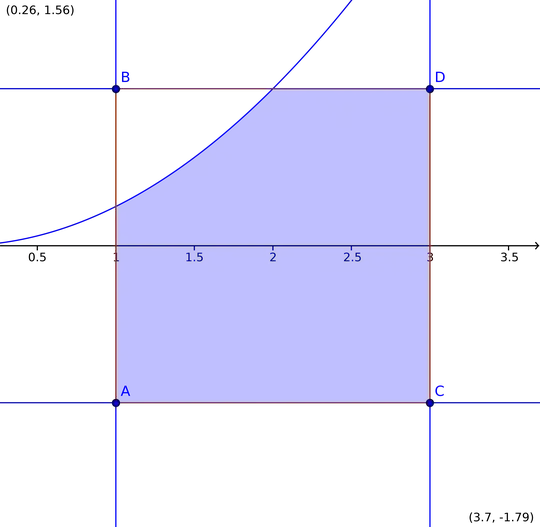Choose two real numbers $a$ and $b$ satisfying $1<a<3$ and $-1<b<1$ randomly.
Find the probability that the polynomial $x^2+ax+b$ has two real roots.
NB: uniform distribution
Choose two real numbers $a$ and $b$ satisfying $1<a<3$ and $-1<b<1$ randomly.
Find the probability that the polynomial $x^2+ax+b$ has two real roots.
NB: uniform distribution
Assuming that the distribution is uniform, you just need to compute the ratio between the shadowed area in the picture and the area of the rectangle.
Looking at $a,b$ as random variables, you just have that \begin{align*} P(a^2-4c>0)=& \frac{1}{6} \left(3+ \int_1^3 \frac 14 a^2 da \right)=\frac{43}{48} \end{align*}
Let $\left[x^{2}>4y\right]$ denote the function with arguments $x,y$ that takes value $1$ if $x^{2}>4y$ and takes value $0$ otherwise.
Then:
$$\begin{aligned}P\left(a^{2}>4b\right) & =\mathbb{E}\left[a^{2}>4b\right]\\ & =\frac{1}{4}\int_{1}^{3}\int_{-1}^{1}\left[x^{2}>4y\right]dydx\\ & =\frac{1}{4}\int_{1}^{3}\int_{-1}^{\min\left(\frac{1}{4}x^{2},1\right)}dydx\\ & =\frac{1}{4}\int_{1}^{3}\min\left(\frac{1}{4}x^{2},1\right)+1dx\\ & =\frac{1}{4}\int_{1}^{2}\left(\frac{1}{4}x^{2}+1\right)dx+\frac{1}{4}\int_{2}^{3}2dx\\ & =\frac{1}{4}\left[\frac{1}{12}x^{3}+x\right]_{1}^{2}+\frac{1}{2}\\ & =\frac{19}{48}+\frac{24}{48}=\frac{43}{48} \end{aligned} $$